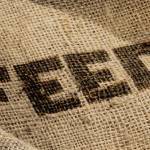Oats: The Perfect Horse Feed?

Oats are oats, right? No, all oats are not created equal.
Most oats fed to horses are whole, meaning each kernel is encased in a hull or fibrous sheath. Oats are frequently subjected to processing, typically rolling or crimping, which cracks the hulls and adds slightly to their digestibility. Hulls constitute a considerable portion of the grain, between 23 and 35% depending on the variety, and are usually over 30% crude fiber. Because of their high fiber content and low energy value, whole oats have traditionally been a relatively safe feed for horses when compared to other cereal grains such as corn.
In an effort to improve upon the nutritional qualities of traditional oats, plant breeders created varieties of hull-less or naked oats. Despite their name, hulls do shroud the kernel while the plant is maturing, but they are paper-thin and loosely attached, so they readily separate from the remainder of the kernel during harvesting. In essence, hull-less oats are self-milling. Hull-less oats and dehulled oats are not one and the same. The hulls of dehulled oats are mechanically removed from the kernel, and this process may leave the kernel damaged and unpalatable. During intensive plant breeding trials, some varieties of naked oats were found to have increased levels of other nutrients, most notably protein, fat, and phosphorus.
Traditional oats contain approximately 9-12% protein, while hull-less oats usually check in at 15-20% protein. Differences in the amino acid profiles of each also exist. Naked oats are believed to contain 62% more lysine (0.65% in naked oats and 0.40% in conventional oats) and nearly double the amount of methionine found in conventional oats (0.40% in naked oats and 0.20% in conventional oats). This is good news for horsemen caring for young growing horses. Lysine and methionine are critical amino acids for proper muscle development and maintenance. A deficiency in either may lead to slow growth or lackluster performance.
Hull-less varieties possess 9-12% fat, considerably more than the approximate 5% found in hulled oats. The additional calories in hull-less oats come from natural oil stores in the kernels. Because the calories are derived from fat and not starch, hull-less oats are less likely to induce digestive disturbancesin performance horses. This nutrient density also translates into savings for horse owners because they can ultimately feed fewer oats while fulfilling basic nutritional needs.
Hull-less oats typically have more phosphorus than hulled oats. Naked varieties may contain nearly 30% more phosphorus, which would make them a wise complement to diets composed largely of high-calcium legume forages such as alfalfa. A combination of naked oats and alfalfa may keep the calcium-to-phosphorus ratio in balance, an important factor to consider when formulating diets for young horses.
Some horsemen may be hesitant to feed hull-less oats because they believe the hulls contribute significantly to fiber intake of horses. Fiber is undoubtedly essential for proper functioning of the equine digestive tract. Horse owners, however, should look toward roughages (hay and pasture, for instance) to satisfy fiber requirements and not grains such as oats. Grains are fed to elevate the energy content of a diet in instances where roughages cannot meet calorie demands brought about by work, growth, or reproduction. And while whole oats do contain significant fiber, it is not the sort easily digested by the horse.
On a pound-for-pound basis, consumers often get more for their money with hull-less oats because of their physical density. For instance, one bushel of premium-quality heavy oats would weigh approximately 36 to 44 pounds. A bushel of hull-less oats would weigh more, perhaps 50 to 55 pounds.
Despite the nutritional advantages of hull-less oats, a few drawbacks do exist. Foremost is the tendency to overfeed them. Because of their increased energy content, hull-less oats do not provide the comfortable margin of safety horsemen associate with whole oats. Naked oats provide 20-30% more calories than traditional oats; therefore, if a horse normally consumes 10 pounds of traditional oats, I may only require 7 to 8 pounds of naked oats to achieve caloric equivalency.
A second disadvantage is cost. Initially, horsemen may back away from the seemingly exorbitant cost of naked oats: some will be charged 20-25% more for hull-less oats than they will for top-of the- line crimped oats. When the dietary energy levels are considered, however, horsemen should realize they are getting about the same value for their dollar.
A final drawback concerns the nutritional profile of any diet composed exclusively of oats (regardless of whether they are hulled or hull-less) and forage. In order to ensure that horses are receiving optimal levels of all essential nutrients, a vitamin and mineral supplement should be top-dressed to oats.








